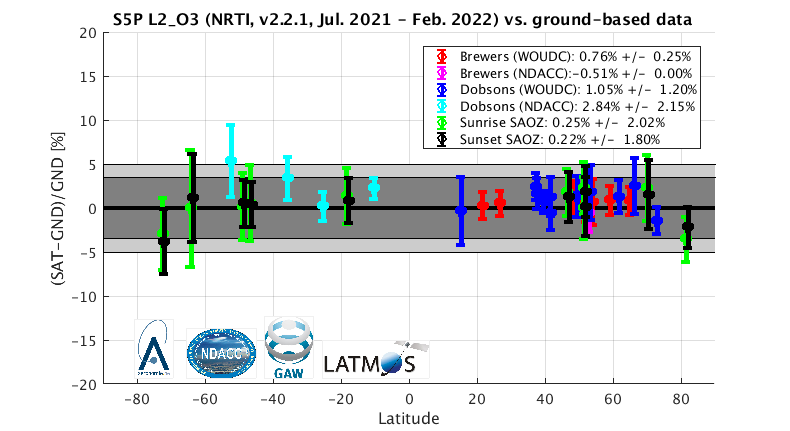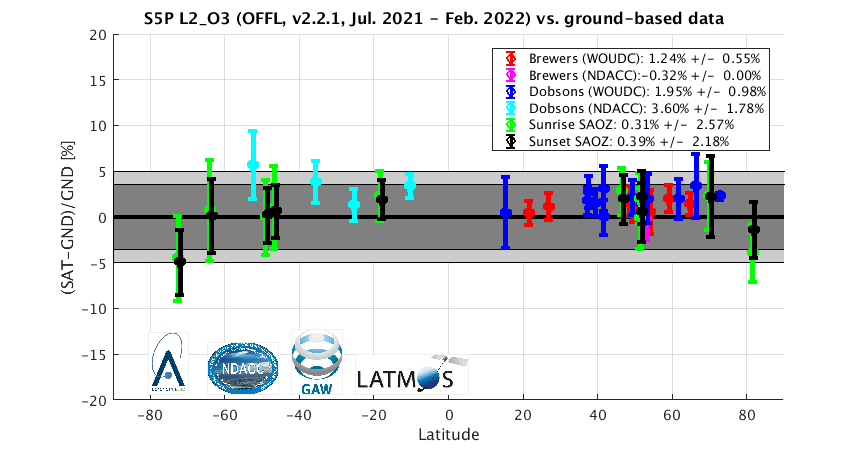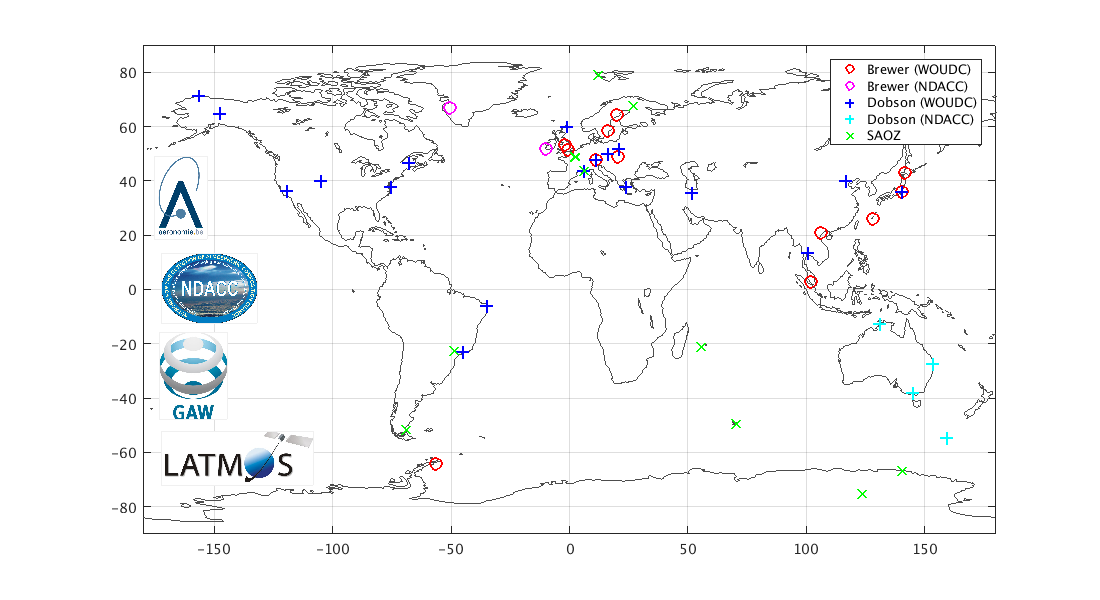Validation Summary
The Sentinel-5p TROPOMI L2_O3 data (both NRTI and OFFL) are in good overall agreement with correlative ground-based measurements from the Brewer, Dobson and NDACC ZSL-DOAS/SAOZ monitoring networks, and also with the MetOp-B GOME-2, Aura OMI, and Suomi-NPP OMPS-nadir satellite instruments. Across the monitoring networks the median bias of about +0.8% (NRTI) and +0.3% (OFFL) and the standard deviation of the relative difference meet mission requirements, that is, a bias lower than 3.5% and an uncertainty due to random errors (dispersion) better than ±2.5%. The instrumental switch to smaller (along-track) ground pixels on the 6th of August 2019 does not alter the agreement with the ground-based reference data. The upgrade of the UPAS processor to version 02.01.03 on 16 July 2020 (NRTI) and 13 July 2020 (OFFL) improves the agreement to ground-based data for the NRTI product over complex snow/ice scenes. The upgrade to version 2.2.1 in early July 2021, using now the new v2 L1b data, causes a slight increase in the S5P ozone columns, and also in the bias w.r.t. the ground-based data, of approximately 0.7% for NRTI and 1.5% for OFFL.
| Product ID | Stream | Version | Orbits | Bias | Dispersion | Special features |
|---|---|---|---|---|---|---|
| L2_O3 | NRTI |
02.03.00 |
22813-now |
0.8% | 2.5% | Improved performance over snow/ice w.r.t. v01.xx.xx. Some increase in overall bias (+0.7%) since v02.02.01 (July 2021) is possible. No detailed results yet for v02.03.00 (since 9 March 2022). |
|
01.01.08 |
12482-14285 |
0.8% | 2.4% | Larger dispersion over snow/ice due to coarse surface albedo climatology (up to v02.01.03). | ||
| OFFL/RPRO |
02.03.00 |
22768-now |
0.3% | 2% | Some increase in overall bias (+1.5%) since v02.02.01 (July 2021) is possible. No detailed results yet for v02.03.00 (since 6 March 2022). |
The graphs below summarize the up-to-date estimates of TROPOMI total O3 data quality obtained from comparisons to ground-based direct-sun and zenith-sky measurements, for the UPASv2.2.1 processor in operation since July 2021 (NRTI in the upper panel, OFFL in the lower panel) ). Shown is the meridian dependence of the median (the circular markers) and spread (±1 sigma, the error bars) of the percent relative difference between S5p and ground-based ozone column data, represented at individual stations from the Antarctic to the Arctic and per measurement type (Brewer, Dobson, and ZSL-DOAS). The values in the legend correspond to the median and spread of all median (per station) differences. For clarity, sunrise and sunset ZSL-DOAS results are represented separately (offset by -0.5˚ and +0.5˚ in latitude).
A detailed description of the method and a comprehensive discussion of validation results can be found in the Quarterly Validation Report #21: April 2018 - November 2023.


Validation Method
Sentinel-5p TROPOMI ozone column data are compared to correlative ground-based measurements collected from several monitoring networks contributing to WMO's Global Atmosphere Watch: direct-Sun observations from Brewer and Dobson UV spectrophotometers, and zenith-sky observations from NDACC DOAS UV-Visible spectrometers (ZSL-DOAS).
Co-locations between TROPOMI and direct-Sun measurements are defined as “pixel contains station”, with a maximum time difference of 3 hours. Note that direct-sun measurements obtained through the NDACC and WOUDC data archives are usually daily means of the individual measurements.
To reduce co-location mismatch errors due to the significant difference in horizontal smoothing between TROPOMI and ZSL-DOAS measurements, TROPOMI ozone column values (from afternoon ground pixels at high resolution) are averaged over the footprint of the larger air mass to which the ground-based twilight zenith-sky measurement is sensitive. For more details about the validation methodology, read Lambert et al. (1997, 1999), Balis et al. (2007), Koukouli et al. (2015), Verhoelst et al. (2015), and Garane et al. (2019).
TROPOMI ozone column data processed with the NRTI and OFFL processors are regularly intercompared.
TROPOMI ozone column data are also compared to alternative retrievals, and to corresponding satellite data from the MetOp-B GOME-2, Aura OMI, and Suomi-NPP OMPS-nadir satellite instruments.
References
- Koukouli, M. E., Lerot, C., Granville, J., Goutail, F., Lambert, J.-C., et al. Evaluating a new homogeneous total ozone climate data record from GOME/ERS-2, SCIAMACHY/Envisat, and GOME-2/MetOp-A J. Geophys. Res. Atmos., Wiley-Blackwell, 2015, 120, 12,296-12,312
- Garane, K., Koukouli, M.-E., Verhoelst, T., Fioletov, V., Lerot, C., Heue, K.-P., Bais, A., Balis, D., Bazureau, A., Dehn, A., Goutail, F., Granville, J., Griffin, D., Hubert, D., Keppens, A., Lambert, J.-C., Loyola, D., McLinden, C., Pazmino, A., Pommereau, J.-P., Redondas, A., Romahn, F., Valks, P., Van Roozendael, M., Xu, J., Zehner, C., Zerefos, C., and
Zimmer, W.: TROPOMI/S5ptotal ozone column data: global ground-based validation and consistency with other satellite missions, Atmos. Meas. Tech., https://doi.org/10.5194/amt-12-5263-2019, 2019. - Verhoelst, T., Granville, J., Hendrick, F., Köhler, U., Lerot, C., Pommereau, J.-P., Redondas, A., Van Roozendael, M., and Lambert, J.-C.: Metrology of ground-based satellite validation: co-location mismatch and smoothing issues of total ozone comparisons, Atmos. Meas. Tech., 8, 5039-5062, https://doi.org/10.5194/amt-8-5039-2015, 2015.
- Balis, D., Lambert, J.-C., Van Roozendael, M., Spurr, R., Loyola, D., et al. Ten years of GOME/ERS2 total ozone data: The new GOME data processor (GDP) version 4: 2. Ground-based validation and comparisons with TOMS V7/V8 J. Geophys. Res., Wiley-Blackwell, 2007, 112, n/a-n/a
- Lambert, J.-C., M. Van Roozendael, M. De Mazière, P.C. Simon, J.-P. Pommereau, F. Goutail, A. Sarkissian, and J.F. Gleason, Investigation of pole-to-pole performances of spaceborne atmospheric chemistry sensors with the NDSC, Journal of the Atmospheric Sciences, Vol. 56, pp. 176-193, https://doi.org/10.1175/1520-0469(1999)056<0176:IOPTPP>2.0.CO;2 , 1999.
- Lambert, J.-C., M. Van Roozendael, J. Granville, P. Gerard, P. Peeters, P.C. Simon, H. Claude and J. Staehelin, Comparison of the GOME ozone and NO2 total amounts at mid-latitude with ground-based zenith-sky measurements, in Atmospheric Ozone - 18th Quad. Ozone Symp., L’Aquila, Italy, 1996, R. Bojkov and G. Visconti (Eds.), Vol. I, pp. 301-304, 1997.
Validation Data
Sentinel-5P TROPOMI L2_O3 total ozone column data are routinely compared to correlative measurements acquired by instruments contributing to WMO’s Global Atmosphere Watch (GAW):
- Brewer UV spectrophotometers (Kerr et al., 1981,1988),
- Dobson UV spectrophotometers (Basher, 1982),
- NDACC Zenith-Scattered-Light (ZSL) DOAS UV-Visible spectrometers (Pommereau and Goutail, 1988, Hendrick et al., 2011).
Brewer and Dobson network data are collected either from the World Ozone and UV Data Centre (WOUDC) or from the NDACC Data Host Facility, depending on the best timeliness. ZSL-DOAS network data are collected from the NDACC Data Host Facility, and from the LATMOS SAOZ Real Time (RT) processing facility for near-real-time validation.

References
- Basher, R. E., Review of the Dobson spectrophotometer and its accuracy, Rep. 13, WMO Global Ozone Res. and Monit. Proj., Geneva, Dec. [Available at http://www.esrl.noaa.gov/gmd/ozwv/dobson/papers/report13/report13.html], 1982.
- Hendrick, F., Pommereau, J.-P., Goutail, F., Evans, R. D., Ionov, D., Pazmino, A., Kyrö, E., Held, G., Eriksen, P., Dorokhov, V., Gil, M., and Van Roozendael, M.: NDACC/SAOZ UV-visible total ozone measurements: improved retrieval and comparison with correlative ground-based and satellite observations, Atmos. Chem. Phys., 11, 5975–5995,
https://doi.org/10.5194/acp-11-5975-2011, 2011. - Kerr, J. B., C. T. McElroy, and R. A. Olafson, Measurements of ozone with the Brewer ozone spectrophotometer, in Proceedings of the Quadrennial Ozone Symposium, Boulder, Colorado, edited by J. London, pp. 74–79, Natl. Cent. for Atmos. Res., Boulder, Colorado, 1981.
- Kerr, J. B., I. A. Asbridge, and W. F. J. Evans, Intercomparison of total ozone measured by the Brewer and Dobson spectrophotometers at Toronto, J. Geophys. Res., 93, 11, 129–11, 140, doi:10.1029/JD093iD09p11129, 1988.
- Pommereau, J. and Goutail, F.: O3 and NO2 ground-based measurements by visible spectrometry during Arctic winter and spring, Geophys. Res. Lett., 15, 891–894, https://doi.org/10.1029/GL015i008p00891, 1988.
VDAF Validation Server
The Routine Operations Validation Service provided by the Sentinel-5p Mission Performance Centre relies on the VDAF Automated Validation Server (VDAF-AVS). This fully automated data analysis system collects correlative measurements from quality-controlled monitoring networks and compares them to Sentinel-5p data using community endorsed protocols. VDAF-AVS outputs a suite of traceable quality indicators enabling users to judge the fitness-for-purpose of the Sentinel-5p data.
The figure below illustrates the automated comparison of Sentinel-5p TROPOMI O3 column data (NRTI) with respect to correlative measurements acquired by the SAOZ instrument at Kerguelen Island (Indian Ocean). More O3 column validation results are available at http://mpc-vdaf-server.tropomi.eu/o3-total-column.
The VDAF Automated Validation Server in brief:
- hosted at BIRA-IASB and operated with s[&]t,
- provides routine validation for the ESA/Copernicus Sentinel-5p Mission Performance Centre,
- ingests correlative measurements from the ESA Atmospheric Validation Data Centre (EVDC) hosted at NILU, collected from ESA's Fiducial Reference Measurements (FRM) programme and from ground-based monitoring networks contributing to WMO's Global Atmosphere Watch,
- builds on heritage from the Multi-TASTE satellite validation system, the QA4ECV validation server (EC FP7 QA4ECV project) and the CAMS NDACC validation server (EC FP7 NORS project),
- is co-funded by ESA and the Belgian Science Policy Office (BELSPO) as a contribution to the Copernicus Space Component.
Latest Issue
Quarterly Validation Report of the Copernicus Sentinel-5 Precursor Operational Data Products #21: April 2018 - November 2023
Archive
Previous issues of the quarterly validation report are archived here.